
"Don't forget the past . Look at the past as if to history. It's telling us that we always need faith to go forward, in technique, sensibilities, ideas. History is relevant to anyone's career. You cannot look only at yourself, otherwise you don't see. You won't know what to do or how to do it... I find inspiration everywhere: in culture, history, books... The best way to know you is to know how to feel secure... Then you will succeed in yourself and in your talents..."
Aldo Coppola, Italian hairstylist.
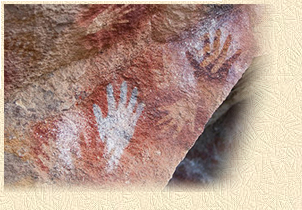 Maybe these hands, engraved in the walls of this cave 20,000 years ago, have been the first to cut human hair, or gave it another shape different than the natural. The art of cutting or grooming hair, is, udoubtedly, one of the most ancient arts in the history of mankind.
Maybe these hands, engraved in the walls of this cave 20,000 years ago, have been the first to cut human hair, or gave it another shape different than the natural. The art of cutting or grooming hair, is, udoubtedly, one of the most ancient arts in the history of mankind.
In the early Paleolithic societies, those who cut the hair were the ones with the highest authority among all the social classes. It was believed that into the hair dwelled the people's soul, so the hair was the way that thoughts were expressed in a physic form. To cut the hair was a way to remove accumulated evil esence and to renew energies. So the task was entrusted to the wisest, the priests.
There were found razors made of sharp stones, from the Bronze Age, 3,500 years old, in excavations in Egypt.
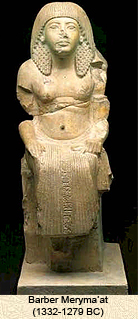 Between the Old Egyptians, barbers were the more distinguished and respected people.
In the tomb Nº 45, in the Lower Cemetery of Thebes, there was found a statuette 19 inches high, from the 18th. Dynasty or maybe older. Which means around 3,300 years old. The figure represents the barber Meryma'at. He was responsible of shaving the Amun Temple priests. It was a rite accomplished every three days, and consisted in shaving them their entire bodies, included the face and the head. Old Egyptians believed that it was a contribution to purify the sacerdotal function. This small statue, in which Meryma'at wears a kilt with many pleats and a wig adorning his head, shows the relevance that barbers had into the Amun's temple, and the high category of their position.
Between the Old Egyptians, barbers were the more distinguished and respected people.
In the tomb Nº 45, in the Lower Cemetery of Thebes, there was found a statuette 19 inches high, from the 18th. Dynasty or maybe older. Which means around 3,300 years old. The figure represents the barber Meryma'at. He was responsible of shaving the Amun Temple priests. It was a rite accomplished every three days, and consisted in shaving them their entire bodies, included the face and the head. Old Egyptians believed that it was a contribution to purify the sacerdotal function. This small statue, in which Meryma'at wears a kilt with many pleats and a wig adorning his head, shows the relevance that barbers had into the Amun's temple, and the high category of their position.
In the Ancient Greece, the profession of barber became very popular. Near the 5th century, men hairstyle was of wavy hair and beards, which they trimmed, curled and combed. At this task barbers were dedicated to. The art of trimming and grooming beards became an important profession in the Ancient Greece. It was there where the first barbershops were created, becoming meeting places, like a kind of clubs, for men, where they enjoyed reunions with long conversations about philosophy, politics, or communal matters. Those barbershops were for them as important as the Agora, their public place of assembly. Barbers' tasks were, besides of trimming and combing hair and beards, massaging, brushing and shining them with lotions, pomades and beeswax. As the Ancient Greeks's hair was of dark color, they also dye it of blond color. The final touch was to parfum hair with scents made of flowers and olive oil. Women used to do their hair dressing into their houses, assited by servants or slaves. In the 3rd century BC, Alexander the Great conquered almost all Asia and he was defeated in several fights against the Persians because of the beards of his soldiers. Persians used to grab them by their beards pulling them off their horses, thus killing them and winning most of the battles. Alexander proclaimed in all his domains an order establishing that all his soldiers ought to be clean shaven. Very soon, the rest of the population adopted the fashion and beards were stopped of using. The more shavings they needed, more job was required from the barbers, who then had to attend their clients every two or three days.
At the first period of the Roman Empire, men use to wear long hair and beards. But the Greek’s influence brought the fashion of the barbers and barber shops. In 296 BC, Ticinius Mena, a Roman Senator, returned to Rome from Sicily, and introduced the custom of the barber shops. According to Plinius the Elder, the first important Roman who was seen with his face clean shaven was the general and consul Scipius the African. That’s the way his image is depicted in an old coin of the 3rd century BC. From that date, it was the hairstyle for men in Rome, almost until the fall of the Empire, when beards and mustaches returned to be used again. Barbers were called “tonsors”, and also between Romans, the tonsorial profession was highly respected. Romans were very concerned about their look, and soon, the “tonstrinae” (barbershops), like in Greece, became an important place of reunion for Roman men. The operation of shaving beards was made only with water and razors made of bronze and sharpened with stones, (these razors were called "novaculae") or by means of depilation with beeswax and tweezers. Besides of cutting their hair, barbers practiced head massages and made their clients some manicure and pedicure services, and also used to perfume their hair with oils and scents. Roman men spent long hours in the barbershops for their hair care. And, even at that age, barbers started also to practice dental extractions. Patricians, who were the people with better social rank, had their own barbers and hair designers among their servitude. And women always had personal hair dressers between their slaves.
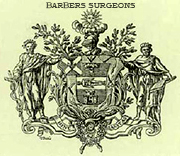
BARBER-SURGEONS:
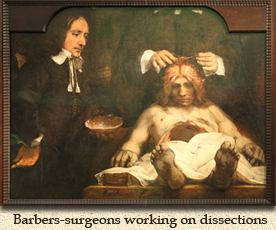 At the fall of the Roman Empire and when the people called by them “barbarians” invaded Europe, all the Romans looked very well clean shaven. But the Franks, Visigoths and other German peoples brought the fashion of beards and long hair. At the Middle Ages, there was an important change in barbers’ activities. All the surgical operations were at that time in hands of the clergymen, who were the only cultivated and educated people at that time. Even the 90% of the nobles were completely illiterate. The priests hired then, to assist them in their medical operations, the only people capable to perform that task: the barbers, who were also familiarized with dental extractions and other minor surgical interventions. The First Council of Lateran of 1123 “peremptorily prohibited the clergy from attending at the bed side of the sick, otherwise than as ministers of religion”. The Second Council of Lateran, in 1139, threatened all priests who persist in the practice of medicine. In
At the fall of the Roman Empire and when the people called by them “barbarians” invaded Europe, all the Romans looked very well clean shaven. But the Franks, Visigoths and other German peoples brought the fashion of beards and long hair. At the Middle Ages, there was an important change in barbers’ activities. All the surgical operations were at that time in hands of the clergymen, who were the only cultivated and educated people at that time. Even the 90% of the nobles were completely illiterate. The priests hired then, to assist them in their medical operations, the only people capable to perform that task: the barbers, who were also familiarized with dental extractions and other minor surgical interventions. The First Council of Lateran of 1123 “peremptorily prohibited the clergy from attending at the bed side of the sick, otherwise than as ministers of religion”. The Second Council of Lateran, in 1139, threatened all priests who persist in the practice of medicine. In  the Council of Tours of 1163, the Pope Alexander III issued a similar prohibition. And in 1215 the Pope Innocent III issued an edict through the fourth Lateran Council , addressed to deacons and priests forbidding them from the practice of operations where blood is present. It’s established, then, than the extraction of human blood (most of the cures were bloodlettings) would be, from then on, a sin of sacrilege for the ministers of God. As a consequence, barbers took all those tasks in their hands.The profession of barber achieved, then, a high category not seen before. And it also started, along the 6 next centuries, a fight and a hard competition between barbers and medical surgeons. Until the 15th century, barbers continued doing surgery and all kind of cures, with no inconvenience. In 1450, in England, b by decision of the Parliament, they would be restricted to bloodlettings, dental extractions and hair care. In the 16th and 17th centuries, barbers were elevated to high positions in the European royal courts. An edict issued by Henry the VIIIth of England allowed them to receive once a year bodies for dissections and the study of human anatomy.
the Council of Tours of 1163, the Pope Alexander III issued a similar prohibition. And in 1215 the Pope Innocent III issued an edict through the fourth Lateran Council , addressed to deacons and priests forbidding them from the practice of operations where blood is present. It’s established, then, than the extraction of human blood (most of the cures were bloodlettings) would be, from then on, a sin of sacrilege for the ministers of God. As a consequence, barbers took all those tasks in their hands.The profession of barber achieved, then, a high category not seen before. And it also started, along the 6 next centuries, a fight and a hard competition between barbers and medical surgeons. Until the 15th century, barbers continued doing surgery and all kind of cures, with no inconvenience. In 1450, in England, b by decision of the Parliament, they would be restricted to bloodlettings, dental extractions and hair care. In the 16th and 17th centuries, barbers were elevated to high positions in the European royal courts. An edict issued by Henry the VIIIth of England allowed them to receive once a year bodies for dissections and the study of human anatomy.
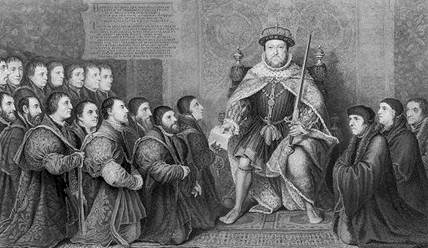 |
| Henry VIII receiving the Barber-Surgeons, by Hans Holbein (1543). |
THE TRUE ORIGIN OF THE BARBER'S POLE

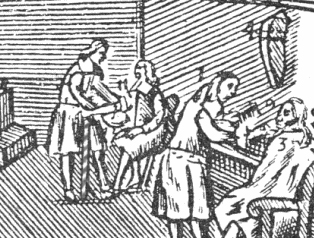 We were told that the barber's pole has its origins in the public announcement in front of barbers' doors to make know at a distance to the weary and wounded traveller where all might have recourse. While the white stripes symbolize the bandages, the red ones mean the color of the blood in bloodlettings and phlebotomies. But, this is a partial explanation. It explains the meaning of the symbol, but not where it came from. Why a pole? In 1658 was published a work titled "Comenii Orbis Pictus", by a Moravian bishop, Iohannes Amos Comenius, which is said to have been the first illustrated school-book printed. In one of these pages, we can see the picture of the interior of a barber's shop. A barber-surgeon is practicing a phlebotomy to a patient. The patient holds in his right hand a pole, which allows to keep his arm horizontal, having a bandage twisted round it. That was the reason of the barber's pole. Surely it was a common tool in barber shops, and it helped to easily identify the place for the traveller. What is clear, is that the origin of this symbol goes far back to distant times; maybe to the Ancient Rome.
We were told that the barber's pole has its origins in the public announcement in front of barbers' doors to make know at a distance to the weary and wounded traveller where all might have recourse. While the white stripes symbolize the bandages, the red ones mean the color of the blood in bloodlettings and phlebotomies. But, this is a partial explanation. It explains the meaning of the symbol, but not where it came from. Why a pole? In 1658 was published a work titled "Comenii Orbis Pictus", by a Moravian bishop, Iohannes Amos Comenius, which is said to have been the first illustrated school-book printed. In one of these pages, we can see the picture of the interior of a barber's shop. A barber-surgeon is practicing a phlebotomy to a patient. The patient holds in his right hand a pole, which allows to keep his arm horizontal, having a bandage twisted round it. That was the reason of the barber's pole. Surely it was a common tool in barber shops, and it helped to easily identify the place for the traveller. What is clear, is that the origin of this symbol goes far back to distant times; maybe to the Ancient Rome.
BARBERS WERE LIMITED TO TONSURAL TASKS:
Until 1745, the guilds of surgeons worked along with the barbers’ guilds. But since that year, by decision of the king George II of Great Britain, both guilds were separated and the barbers were restricted only to their tasks of hair care. The king Louis XIV, in France, will take the same decision years later. It produced a decline and a loss of prestige in the profession. Since the second half of the 17th century, barbershops became unsanitary places frequented by people of low social level, and the barbers lose respect and social rank.
WIG MAKERS :
However, a new approach about people's hairstyles, provoked that in the second half of the 18th century, barbers recovered their social relevance. The growing use of wigs, since the last decades of the 17th century, achieved that barbers became wig makers and wig designers. Those professionals, besides of wigs making and installation, were in charge of their periodical maintenance. If barbers at that time had work order software they would be automatically reminded when maintenance was due. Our technological age may depend on work order software, but barbers had to have their daily work organized so they could keep their wigs in perfect shape.Those wigs of the 18th century were famous by their spectacular and elegant designs. In some moment, everybody started to wear wigs: men used slightly powdered wigs with a whitish-gray color, and women, since1770, wigs of all kind of colors, towered hair dressings, until the end of the century. The design of those wigs was a complicated labor and it became a first class industry. Best and more expensive wigs were made of human hair, and the cheaper ones, of cotton fibers or animal hair. When the design of the wig was finished, it was perfumed with citric flowers and after that, it was powdered with starch or colored powders. Wig factories were important industries, giving jobs to many people. There were some factories in Europe with more than 600 employees. The fire of one of these factories was famous in 1729 because it almost completely destroyed the city of York, in England. Around 1750, a famous English barber, Richard Arkwright, discovered a formula of dye for wigs which was not deleted by the water. Later, working in wig making, Arkwright invented a water powered cotton mill which was the precursor of modern cotton processors.
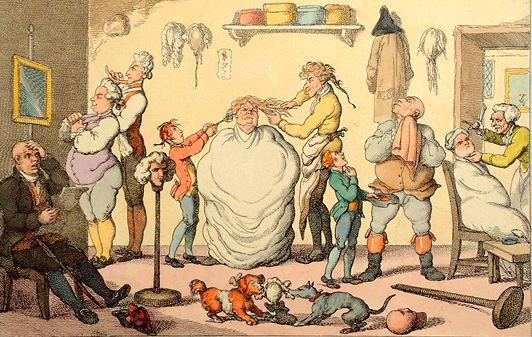
Barbershop at the Eighteenth century.
THE REBORN OF THE BARBER'S PROFESSION :
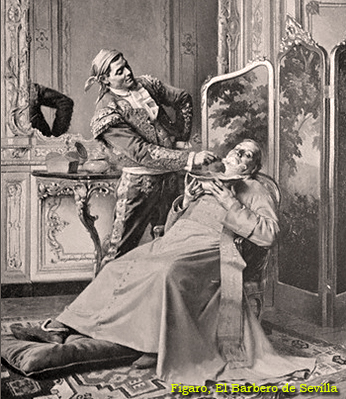
Wig makers had their golden age during the 18th century, but, after the French Revolution, as a rejection to the Old Regime, people stopped using wigs, and then became popular the tendencies of hairstyles with natural hair. However, into the courts and Parliaments powdered wigs were in use for a long more time. But wig makers, in the 19th century, had very little activity, because almost nobody was using more wigs. They still were working in the hair cutting, trimming of beards and hair designs.
In spite that they were not more allowed to do it, in many places barbers still were practicing bloodlettings and dental extractions, especially in towns where the professionals of medicine were not at the hand. But since 1850 this practice were absolutely eliminated. The profession was then re-organized, based only in the hair care.
After the second half of the nineteenth century, there were barbershops in all the cities and in all the small towns, and chains of barbershops started to be inaugurated. Barbers recovered their social prestige and the activity had a glorious reborn, which motivated the search of new standards and regulations to make the profession more reliable and prestigious.
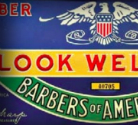 In 1886 was formed the Barbers' Protective Union en Columbus, Ohio, and in 1887 the Journeymen Barbers International Union in Buffalo, New York. This union is today the Barbers, Beauticians and Allied Industries International Association. Together with the new associations, different barber schools were founded. It was necessary to secure a good level of professional work, by means of licenses and an adequate training and education.
In 1886 was formed the Barbers' Protective Union en Columbus, Ohio, and in 1887 the Journeymen Barbers International Union in Buffalo, New York. This union is today the Barbers, Beauticians and Allied Industries International Association. Together with the new associations, different barber schools were founded. It was necessary to secure a good level of professional work, by means of licenses and an adequate training and education.
At the beginning of the 20th century, the unions imposed a more scientific level to the profession, with the assistance of chemistries, chiropractics, anatomists and biologists. In 1924 was founded the Associated Master Barbers of America (AMBA) in Chicago. This union was later renamed as Hair International. At the first transoceanic trips, the ship lines provided their passengers with a barbershop service, so they could look well shaven along the trip over the ocean.
During almost all the 20th century, barbershops were only for men or only for women. At the end of the 1970s, men started to wear very long hair, long sideburns and perms, many times lacquered. The traditional male barbershops, usually, did not attend those kinds of services, more related with the women's beauty salons, and, in consequence, the barbers' reaction was to expand their clientele and to offer their services to both men and women. In the 1980s unisex barbershops started to be every day more common, and in the 1990s, almost all the salons were giving services to both genders. Actually very few salons give services only for men or women. Today, hairstylists are regularly for everybody and even their names are vaguely unisex: "hair salons".
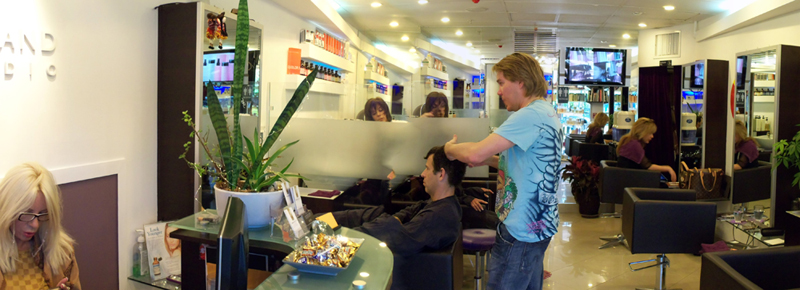 GUSTAVO BRIAND STUDIO AT MIAMI BEACH, FLORIDA
GUSTAVO BRIAND STUDIO AT MIAMI BEACH, FLORIDA
| DEUTSCH |
ENGLISH |
ESPAÑOL |
FRANÇAIS |
ITALIANO |
русский |
SRPSKI |
| Start | The Hair | What the Hair is | Prehistory | Mythology | Old Age (1st. part) | Old Age (2nd. part) |
| Middle Ages/Renaissance | 18th Century | 19th Century | 20th Century | Barbers' History | The End | Contact |